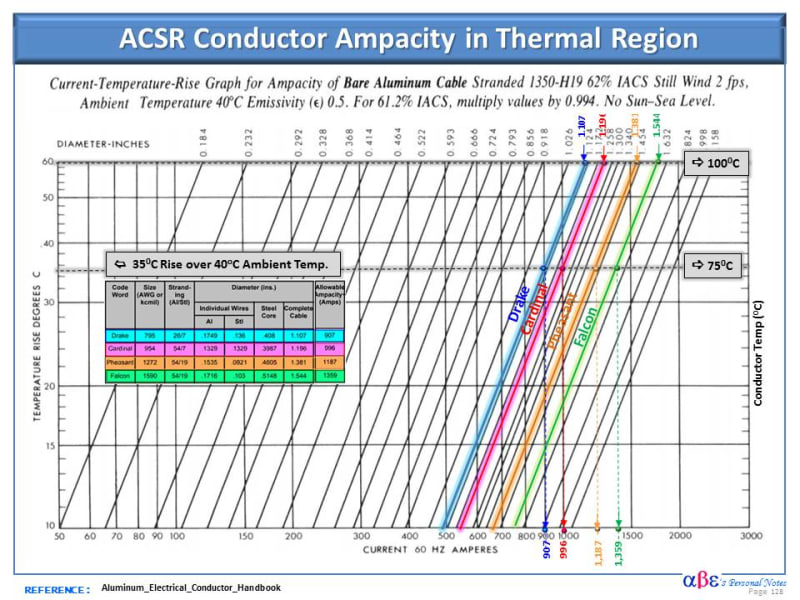Anyone know how to properly calculate the actual current rating of twined Drake, Cardinal, Pheasant and Falcon? When designing new circuits under 345kv is there any advantage to twin vs single conductors? Also what risk is there in operating line hardware above 100*C (in 35*C ambient sun + 2ft/sec wind) 6-8 hours of the day about half the year?
Navigation
Install the app
How to install the app on iOS
Follow along with the video below to see how to install our site as a web app on your home screen.
Note: This feature may not be available in some browsers.
More options
Style variation
-
Congratulations MintJulep on being selected by the Eng-Tips community for having the most helpful posts in the forums last week. Way to Go!
You are using an out of date browser. It may not display this or other websites correctly.
You should upgrade or use an alternative browser.
You should upgrade or use an alternative browser.
Ampacity of Bundled Conductors 2
- Thread starter Mbrooke
- Start date
- Status
- Not open for further replies.
I have never tried this program:
It can be useful ...
It can be useful ...
- Thread starter
- #3
Above 230kV, the allowable conductor surface gradient becomes one of the governing factors in conductor selection. RUS Bulletin 1724e-200 recommends that max conductor gradient shall not exceed 16kV/cm. Using 795 drake as an example on 230kV line, you will get 15.9kV/cm conductor gradient. As conductor surface gradient is the function of line to line voltage, you will probably need bundle configuration on lines of 230kV or higher voltage levels.
-
1
- #5
The twin cable is twice the ampacity as a single cable as shown in the edited graph and table below.
To close match the circuit breaker or transformer FLC, it is customary to use a twin conductor for many applications up to 230 kV. This allows maximizing the system capacity for any future use without letting the conductor be the limiting factor.
One of the major concerns is to violate the NESC clearance do to excessive line sagging. Another concern is to have permanent conductor deformation or annealing the aluminum that may compromise the strength integrity of the line.
>>>>>>

- Thread starter
- #6
- Thread starter
- #7
-
1
- #8
- Thread starter
- #9
Mbrooke,
Per your request, enclosed is the upload edited graph indicating the thermal behavior of the ACSR conductor under the conditions indicated.
Beware that this graph is a simplified approach that provides a rough performance of the ACSR cables.
I hope this became more clear in pdf format.
[URL unfurl="true"]https://res.cloudinary.com/engineering-com/image/upload/v1588344962/tips/ACSR_Ampacity_Graph_nocuif.pdf[/url]
Per your request, enclosed is the upload edited graph indicating the thermal behavior of the ACSR conductor under the conditions indicated.
Beware that this graph is a simplified approach that provides a rough performance of the ACSR cables.
I hope this became more clear in pdf format.
[URL unfurl="true"]https://res.cloudinary.com/engineering-com/image/upload/v1588344962/tips/ACSR_Ampacity_Graph_nocuif.pdf[/url]
- Thread starter
- #11
Much appreciated.  It is finally clear.
It is finally clear.
What are you getting for Bluebird BTW? Sag aside I'm at 1,600 amps 100*C, 35*C ambient sun+win.
Am I also correct to assume some annealing from STE loading is ok? I'm reading that the steal would not be effected and compensate for the 10% loss of AL strength provide this is originally factored in during the line designing stage.
What are you getting for Bluebird BTW? Sag aside I'm at 1,600 amps 100*C, 35*C ambient sun+win.
Am I also correct to assume some annealing from STE loading is ok? I'm reading that the steal would not be effected and compensate for the 10% loss of AL strength provide this is originally factored in during the line designing stage.
- Status
- Not open for further replies.
Similar threads
- Locked
- Question
- Replies
- 3
- Views
- 4K
- Locked
- Question
- Replies
- 16
- Views
- 6K
- Locked
- Question
- Replies
- 1
- Views
- 817
- Locked
- Question
- Replies
- 7
- Views
- 1K
- Locked
- Question
- Replies
- 5
- Views
- 353
